Trumpeter 1/32 Me 262A-1a
|
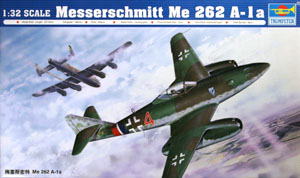 |
History
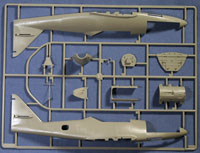 The Messerschmitt Me 262A, being the first operational jet fighter,
has had quite a bit written about it, both on the web and in print. Rather
than bore you with a short canned history of this well-documented aircraft,
I will recommend you to your favorite Me 262 book (for what is likely
the most thorough history of the type, I would suggest the Classic Publications
four-volume set on the Me 262). The Messerschmitt Me 262A, being the first operational jet fighter,
has had quite a bit written about it, both on the web and in print. Rather
than bore you with a short canned history of this well-documented aircraft,
I will recommend you to your favorite Me 262 book (for what is likely
the most thorough history of the type, I would suggest the Classic Publications
four-volume set on the Me 262).
The Kit
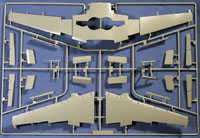 A
1/32 Me 262, you say? Didn't Hasegawa do one of those ages ago? Well,
yes, they did, and it was a very nice kit for its day. This new Trumpeter
kit outshines it in just about every way, though, and it won't be long
before we see those Hasegawa kits being dumped on eBay left and right.
As we would expect from Trumpeter, this kit comes molded in a light gray
plastic, with finely recessed panel lines throughout. There are some
interesting features, such as clear engine nacelles, white metal landing
gear, photoetch seatbelts, and rubber tires, making this model a multimedia
construction A
1/32 Me 262, you say? Didn't Hasegawa do one of those ages ago? Well,
yes, they did, and it was a very nice kit for its day. This new Trumpeter
kit outshines it in just about every way, though, and it won't be long
before we see those Hasegawa kits being dumped on eBay left and right.
As we would expect from Trumpeter, this kit comes molded in a light gray
plastic, with finely recessed panel lines throughout. There are some
interesting features, such as clear engine nacelles, white metal landing
gear, photoetch seatbelts, and rubber tires, making this model a multimedia
construction 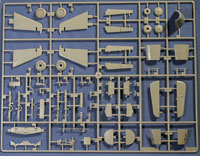 experience. The decal sheet provides markings for a couple
of aircraft and are well printed and colorful. experience. The decal sheet provides markings for a couple
of aircraft and are well printed and colorful.
Starting with the cockpit, this is a well-detailed interior. Expect
to spend quite a bit of time here, as not only is the cockpit tub visible
from above, but it is also seen from below, through the main gear wells.
The construction of this tub is interesting, being split into an upper
and lower section. The lower section gets all the separate details such
as the rudder pedals and seat, while the upper section sandwiches everything
in place. The completed tub is then 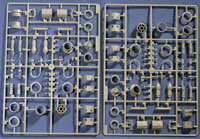 attached to a forward and a rear
bulkhead, which makes up the rest of the main gear well detail. When
finished, this could almost stand on its own as a kit. attached to a forward and a rear
bulkhead, which makes up the rest of the main gear well detail. When
finished, this could almost stand on its own as a kit.
Detail is the main point of this kit, and next up is the gun bay. This
is just as detailed as the cockpit, which is nice considering that the
model comes with a separate hatch over the guns. The complete assembly
also includes the nose wheel well, and again the detail is high enough
that modelers will want to leave things open, just to show it all off.
I guess this is why Trumpeter chose  to provide clear engine nacelles,
as the next step is to assemble the Jumo 004 engines. These are beautifully
done, with the only thing missing being some of the plumbing. For those
who want to add that detail, we have a series of detail
photos from our
Aviation What-Not days that should be of some help. to provide clear engine nacelles,
as the next step is to assemble the Jumo 004 engines. These are beautifully
done, with the only thing missing being some of the plumbing. For those
who want to add that detail, we have a series of detail
photos from our
Aviation What-Not days that should be of some help.
After the main detail assemblies are finished, the rest of the construction
is quite straightforward. The wings are in three main pieces, with the
lower one-piece wing  maintaining the dihedral. The wing has separate
control surfaces all around, including flaps and slats. The tailplanes
follow suit, with separate rudder and elevators. The fuselage halves
have sidewall detail stretching down the entire length, with additional
accessory bits providing even more detail. The landing gear is beefy,
being white metal, and two styles of nose wheels are provided. maintaining the dihedral. The wing has separate
control surfaces all around, including flaps and slats. The tailplanes
follow suit, with separate rudder and elevators. The fuselage halves
have sidewall detail stretching down the entire length, with additional
accessory bits providing even more detail. The landing gear is beefy,
being white metal, and two styles of nose wheels are provided.
The decals provide markings for two aircraft, as well as a complete
set of national markings and stenciling. The first aircraft is Red 4
from 10./JG 7, flown by Franz Schall in April of 1945. This plane features
the red/blue bands around the rear fuselage, and a camouflage of RLM
81/82 over RLM 76. The second option is Major 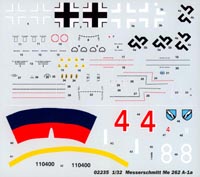 Walter Nowotny's White
8, from Kommando Nowotny out of Achmer in 1944. This plane, also camouflaged
in RLM 81/82 over RLM 76, has yellow cowling fronts and a thin yellow
fuselage band. All of the decals are well printed and have good register. Walter Nowotny's White
8, from Kommando Nowotny out of Achmer in 1944. This plane, also camouflaged
in RLM 81/82 over RLM 76, has yellow cowling fronts and a thin yellow
fuselage band. All of the decals are well printed and have good register.
Conclusion
This is an outstanding kit of the famous Me 262, and it easily surpasses
the old Hasegawa kit in terms of detail. My thanks to Stevens International
for the review sample.
|
|
